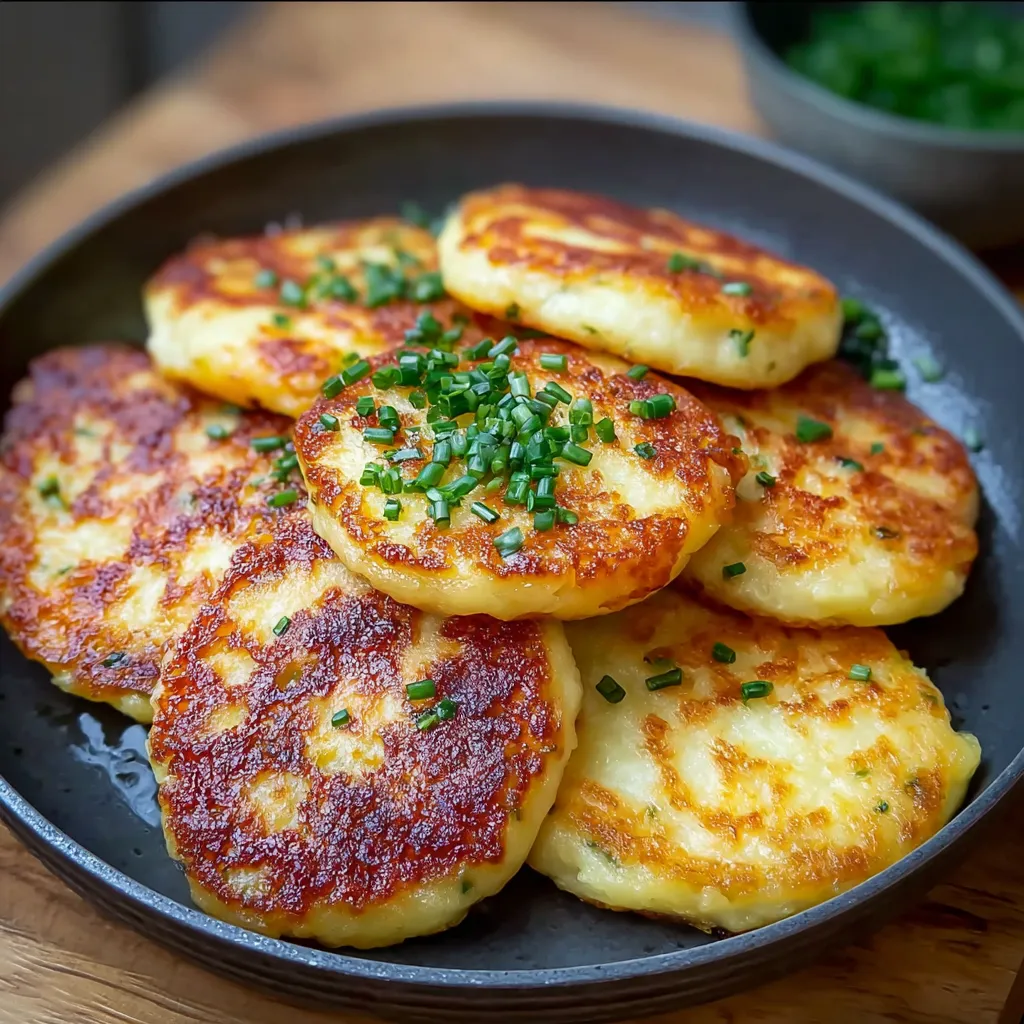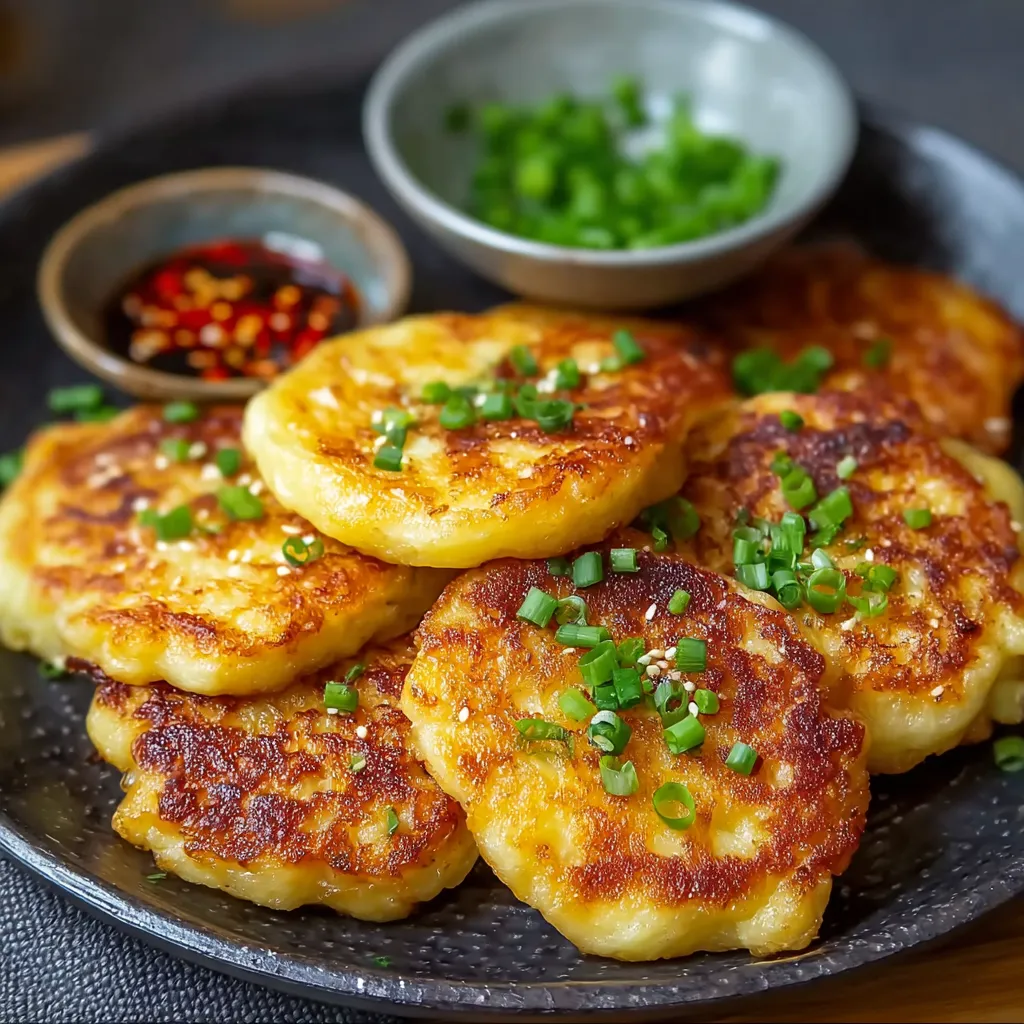 Bookmark
Bookmark
This potato cheese pancake recipe transforms humble potatoes and cheese into a mouthwatering Korean street food experience right in your kitchen. The contrast between the crispy exterior and gooey cheese center creates an irresistible texture that will have everyone reaching for seconds.
I first made these pancakes when searching for creative ways to use leftover potatoes. Now they've become my go to comfort food on rainy days, and friends always request them when they visit.
Ingredients
- Russet potatoes perfect for their high starch content that creates the ideal crispy texture when fried
- Salt enhances the natural flavor of potatoes and helps draw out moisture
- Black pepper adds a subtle warmth that complements the mild potato flavor
- Cornstarch creates an extra crispy exterior while helping bind the pancakes
- Mozzarella cheese provides that perfect stretchy cheese pull when melted look for low moisture variety for best results
- Butter or cooking oil for that golden exterior use butter for extra flavor or neutral oil for a cleaner taste
- Green onions optional but add a fresh pop of color and mild onion flavor
Step-by-Step Instructions
- Soak the Potatoes
- Grate your peeled potatoes using the large holes of a box grater. Immediately place them in cold water and let them soak for 5 minutes. This crucial step removes excess starch which prevents gumminess and ensures crispy pancakes.
- Drain and Dry
- Transfer the soaked potatoes to a clean kitchen towel. Gather the corners and twist tightly over the sink, squeezing out as much moisture as possible. The drier your potatoes, the crispier your pancakes will be. Keep squeezing until barely any water comes out.
- Season and Mix
- Place the squeezed potatoes in a mixing bowl and add salt, pepper, and cornstarch. Mix thoroughly with your hands to ensure the seasoning and starch coat each strand of potato. The cornstarch will help bind everything while adding extra crispiness.
- Prepare the Pancakes
- Take about 2 tablespoons of the potato mixture and flatten it in your palm to form a thin disc. Place a generous tablespoon of shredded mozzarella in the center, then fold the potato mixture over the cheese. Gently press the edges to seal, forming a flat patty about 3 inches in diameter.
- Cook to Crispy Perfection
- Heat your skillet over medium heat and add butter or oil. Once hot, place the pancakes in the pan with enough space between them. Cook undisturbed for 3 to 4 minutes until the bottom is golden brown, then carefully flip and cook for another 3 to 4 minutes. The cheese should be fully melted inside.
- Serve and Garnish
- Transfer the finished pancakes to a paper towel to drain any excess oil. Sprinkle with freshly chopped green onions and serve immediately while the cheese is still hot and stretchy.

My favorite part of making these pancakes is the moment of flipping them and hearing that satisfying sizzle. It reminds me of watching street food vendors in Seoul effortlessly creating these delicious treats on massive griddles while crowds gathered around.
Make Ahead Options
While these pancakes are best enjoyed fresh off the skillet, you can prepare the potato mixture up to 24 hours in advance. Store it in an airtight container with a paper towel on top to absorb any moisture that might release. When ready to cook, simply form the pancakes with cheese and proceed with cooking. This preparation method makes them perfect for entertaining when you want to minimize last minute work.
Flavor Variations
The basic recipe is delicious on its own, but you can customize these pancakes in countless ways. Try adding minced kimchi to the potato mixture for a spicy Korean twist that pairs beautifully with the cheese. For an herbal note, mix in chopped chives or dill. You can also experiment with different cheeses cheddar offers a sharper flavor while fontina provides an even meltier texture. For meat lovers, adding small pieces of cooked bacon or ham creates a more substantial snack.
Serving Suggestions
In Korea, these potato pancakes are often enjoyed as a street food snack, but they make a versatile addition to any meal. Serve them as an appetizer with a simple dipping sauce made from equal parts soy sauce and rice vinegar with a touch of sugar. They also make an excellent side dish alongside grilled meats or a fresh salad. For a complete meal, pair with a bowl of kimchi jjigae or a simple vegetable soup. I particularly enjoy them for brunch topped with a fried egg for an indulgent weekend treat.
Common Recipe Questions
- → How do I ensure my potato pancakes are crispy?
For crispy pancakes, thoroughly squeeze out moisture from the grated potatoes using a kitchen towel. Cook on medium heat with enough butter or oil, and don't flip them too early—allow 3-4 minutes per side until they develop a golden-brown crust.
- → Can I make these pancakes ahead of time?
While best served immediately for the optimal cheese pull and crispy texture, you can prepare the potato mixture a few hours ahead and keep it refrigerated. For leftovers, reheat in a hot skillet or oven at 350°F for 5-7 minutes to restore crispiness.
- → What can I serve with Korean potato cheese pancakes?
These pancakes pair wonderfully with a simple dipping sauce made from soy sauce, rice vinegar, and a touch of sesame oil. They're great alongside kimchi, as part of a Korean meal, or simply as a snack with cold beer or makgeolli (Korean rice wine).
- → Can I use different types of cheese?
Mozzarella works best for its meltability and subtle flavor, but you can experiment with cheddar, Monterey Jack, or a Korean cheese like Ssamjang cheese. Just ensure whatever cheese you use melts well and complements the potato flavor.
- → What's the best way to grate the potatoes?
Use the large holes of a box grater for the ideal texture. A food processor with a grating attachment also works well for larger batches. The grated pieces should be thin but not mushy—about matchstick size for the best texture in the final pancakes.
- → Are these pancakes gluten-free?
Yes, this recipe is naturally gluten-free as it uses cornstarch instead of wheat flour as the binder. Just ensure your cornstarch is processed in a gluten-free facility if you have celiac disease or severe gluten sensitivity.
